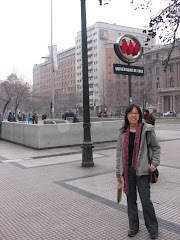I recently moved from a very nice house (which I was house-sitting for a missionary family), to a very cute apartment right around the corner from our English language institute, where I work. (For you New Yorkers, this would be somewhat akin to moving from Westchester to the Village - less space & comfort, much more central location.)
The owner we're subletting from owns a restaurant and lived in Spain for 11 years. We're also neighbors with a dentist, and we have a security guard, so it's basically an upper-middle-class building. And our apt's pretty nice - 3 bedrooms, living room, kitchen & laundry, probably about a 900 sq. ft in all. However it's also got no heating, so it's freezing at night; the pipes in my bathroom smell like raw sewage; and we rely on a small hot water tank for hot water, so we have to switch it on 30 min before a shower, jump in the shower for 5 min before it runs out, wait another 30 min for the second person to shower, etc. We also hang our laundry to dry on clotheslines - no dryers.
It is an interesting, and humbling, thing to meditate on the differences in living standards between a "moderately poor" country like Peru and the US. Here I am living in fairly pituco* surroundings, among the upper echelons of society (and indeed, to be a gringo or foreigner here is to be automatically regarded as a VIP... hmm disturbing), yet I can't get over my nagging cough and I'm freezing all the time. And no matter how much money you have, you can't escape from frequent outages of power and water.
I've had the chance to get to know people from a variety of social classes here. Some are university students who wear nice clothes and have some disposable income, but live at home, only get running water at certain hours of the day, and can't find a job. Many more are from poorer neighborhoods, living in ramshackle self-built adobe houses with tin roofs and gaps in the walls, and the humblest of accoutrements. And then there are the street boys I first met in 2004, who were from the poorest and most troubled of homes, and spent most of their time on the streets, dirty and hungry and high.
It is humbling to actually know some of the billions of people who live on a few dollars a day, living on rice and potatoes and a few vegetables (meat's a luxury too!), constantly vulnerable to being wiped out by the sudden cost of a hospital visit or a defaulted loan or a husband leaving them. However, short of these extremes, it is also oddly liberating to realize you CAN live on much less money, if you are willing to give up some creature comforts and "luxuries", and rely on your friends and neighbors a little more than we like to do in the States. Doesn't Shakespeare (and the Bible) say somewhere that both wealth and poverty are dangerous, and it's best to live somewhere in between?
All I know is, living with less comfort, less control, and less water pressure has made me realize how much I take for granted (and how much energy I consume) at home.
*see my post of Sept. 2

My new 'hood

A typical neighborhood for much of Trujillo
